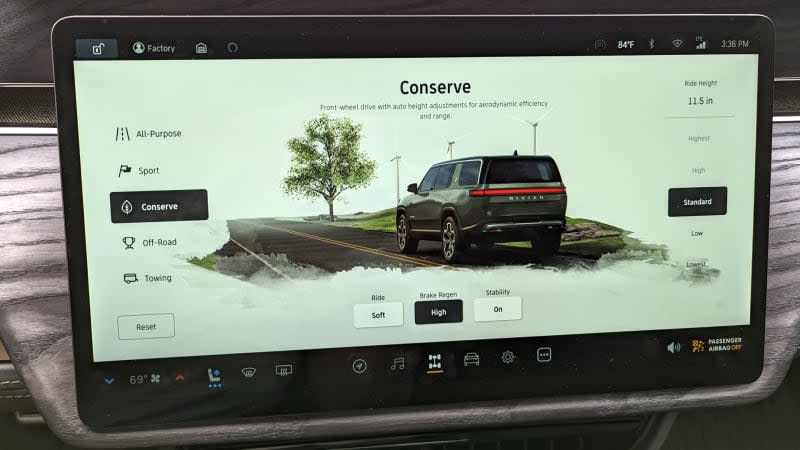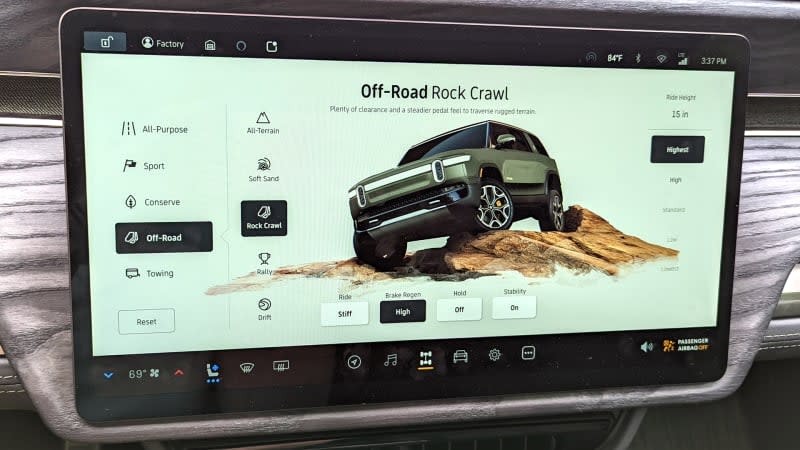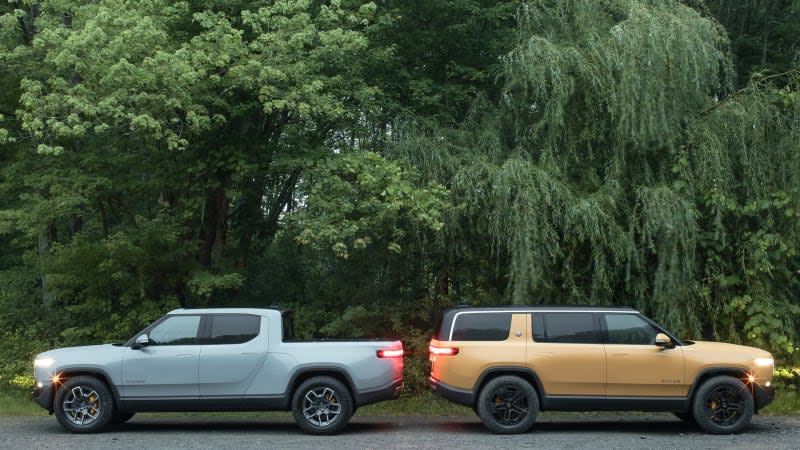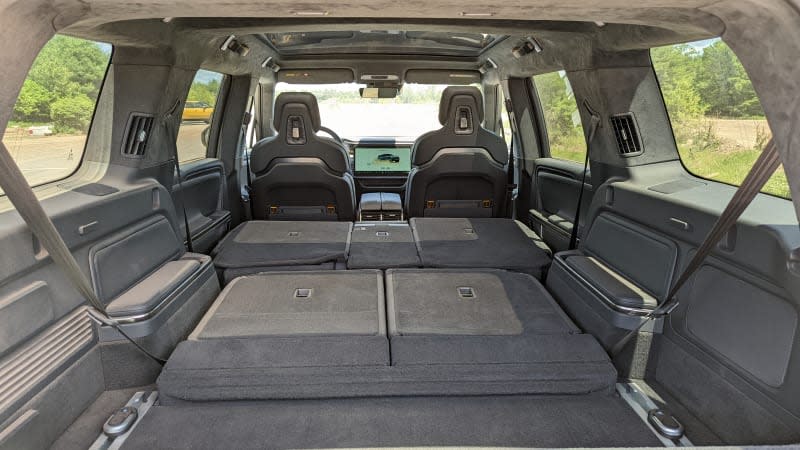Rivian R1S First Drive Review: The SUV finally arrives! (Sort of)

WINDHAM, N.Y. – There aren’t a lot of options in the seven-passenger, fully-electric SUV market, but startup automaker Rivian is working to change that with the launch of its second vehicle, the 2022 Rivian R1S SUV. We spent a few days in midstate New York to find out just how it performs both on-road and off.
On the road, the Rivian R1S is surprisingly agile and comfortable without being numb. Rivian sent us off in the second most-expensive model available, with quad motors and the larger battery pack. Each wheel is effectively powered by its own motor, allowing for independent torque vectoring front and rear. The motors that power the front wheels put out 415 horsepower with 435 pound-feet of torque, while the rear motors put out 420 horsepower and 495 lb-ft of torque, giving the quad-motor R1S a tremendous total of 835 horsepower and 908 lb-ft of torque. A 0-60-mph sprint takes an estimated 3 seconds.
Underpinning the R1S is a choice of battery packs: A standard pack that gives you around 260 miles of range, a large pack (which was in the vehicle we drove) that Rivian says gives an EPA-estimated range of 316 miles, and a max pack that should get around 400 or more miles of range.
Our test drives took us from Windham, N.Y., down to Monticello, N.Y., on a route clogged by construction, pedestrians and small towns with low speed limits. Getting a full taste for those 835 horses was therefore difficult, but a few short acceleration runs at least hinted at how quick the R1S can be. The more lasting on-road impression was just how little wind noise makes its way into the cabin at highway speeds.


The R1S has 10 driving modes, including All-Purpose, Sport, Conserve, Off-Road, and Towing, with a collection of sub modes beneath Off-Road. The Soft Sand mode under the Off-Road section is new, and was launched as an over-the-air update, after feedback from the Rebelle Rally Team that ran the R1T in the women-only off-road navigational rally last October, which I also participated in. Along those lines, Rivian has been delivering R1S vehicles to employees first so they can work out the last few bugs before putting them into customers hands, and the company takes feedback very seriously.
In addition to these modes, there is also a Drift Mode, which we got to experience from the passenger seat in an R1T driven by Max Koff, the Director of Vehicle Dynamics. The R1S also gets Drift Mode, but Rivian said it didn’t put it on display for journalists because the R1S apparently becomes “more mid-engine-oriented” in Drift Mode, and conditions at the track weren’t suited to keeping the R1S in a slide.
Selecting from the menu of drive modes is done using the 15.6-inch touchscreen, which also controls virtually everything else: infotainment, climate, seat positioning and mirrors, plus details about efficiency and state of charge. There are no buttons except a pair of rockers on each side of the steering wheel in the R1S, much like the R1T. In fact, from the front seat, both the interior of the pickup and the SUV look identical.
In each mode, you can customize ride height (ranging from 9.5 inches in Lowest to 15 inches in Highest), and three levels of brake regen using the touchscreen. All-Purpose and Sport modes were our favorite for the on-road portion of the drive, as these two modes provided enough steering feedback and control, while not jostling passengers. The most uncomfortable mode was Conserve mode, which lowers the R1S to its lowest clearance height and puts it into front-wheel-drive mode with the highest regenerative braking. Rivian Engineers confirmed that Conserve mode is really best suited for smooth highway driving, not the winding single-lane roads of our drive because, at its lowest suspension height, the R1S translates nearly every undulation and bump directly into the cabin. Without any towing to do during this test, Tow Mode went unused, but the setup would’ve kept the R1S in AWD and put down the maximum torque.
Off-road, the R1S is impressively capable, much as we discovered the Rivian R1T to be during a more extensive off-road journey than we managed in New York. In the R1S, we ran a short, lightly technical, off-road course set up by Rivian at the Monticello Motor Club, back-to-back in the R1S and the R1T. The shorter R1S made it easier to maneuver across a small creek and up a steep, sandy grade, though the R1T felt more sure-footed on the same route. The Off-road modes are very well dialed in and certainly make off-roading far more attainable for first timers and families.


From the outside, the R1S shares a lot of visual cues with the Rivian R1T. The R1S, however, is a full 17.1 inches shorter than its pickup sibling, but still packs plenty of usable space inside. With both rear seating rows lowered, there’s 88.2 cubic-feet of cargo capacity, which is roughly what you’d get in a Kia Telluride and Volvo XC90. Despite the length difference, the curb weight of just under 7,000 pounds is the same for both the R1T and R1S.
The R1S gets the same lighting signature, both front and rear, as the R1T, with looping daytime running lights that run horizontally from side to side. It also gets a massive panoramic roof, as standard across the model line. That glass portion stretches from the front to rear seats making the interior feel open and airy, which is quite nice when sitting in the rear seats. Unfortunately, there is no sunshade for that glass panel, and although Rivian initially promised an electrochromic glass roof that would go opaque at the press of a button (presumably in the touchscreen), that feature apparently never made it to production. As is, there is only tinted glass between you and the sun, which is just not enough. Then again, this is also a trend we've seen elsewhere in the electric car arena (Mustang Mach-E, various Teslas) and it's not a good one.
Second-row seating is a 40/20/40-split setup with ample legroom for a pair of 6-foot adults to fit comfortably there for a long ride. The seats are firm but comfortable, and the seatbacks tilt to provide more comfort. The outboard seats slide to increase space for cargo or third-row passengers.

 Yahoo Autos
Yahoo Autos 
